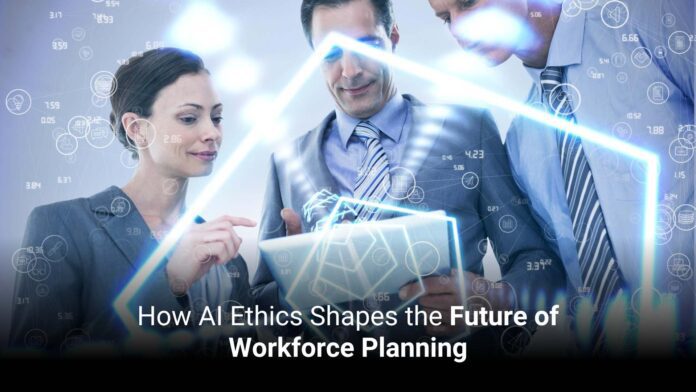A company adopts an AI platform to streamline its workforce planning. The system promises to predict talent shortages, optimize hiring decisions, and even automate role allocation. But within months, troubling patterns emerge. Certain employees feel overlooked for promotions, while others question the fairness of the algorithm for hiring decisions. This scenario highlights why AI Ethics should be part of Workforce Planning.
AI Ethics in workforce planning is about embedding accountability into decision-making. For example, when AI models predict skill gaps, it is essential to ensure that these insights are unbiased and easily explainable to employees. Ethical AI guardrails help align workforce strategies with the organization’s vision, without compromising employees’ dignity.
This article will explore how AI ethics shape workforce planning.
Why AI Ethics Matters in Workforce Planning
Here’s why AI ethics is important for workforce planning.
- Ensures Fairness in Talent Management
Workforce Planning with AI ethics can identify high-potential employees, but without it, algorithms may favor specific demographics over others.
Example: An IT services firm used AI for succession planning. Ethical oversight ensured promotions were based on skills and performance data rather than biased patterns.
- Builds Employee Trust and Engagement
Transparent communication about how AI influences hiring, promotions, or workforce reductions is critical for maintaining trust. Ethical AI frameworks reassure employees that decisions are explainable, which impacts engagement scores and reduces attrition risk.
- Supports Compliance and Risk Management
Regulators are tightening rules around algorithms and workplace fairness. Ethical AI safeguards organizations from legal and compliance risks.
Example: A financial services provider introduced AI to forecast skill shortages. By embedding AI Ethics into its Workforce Planning, the firm ensured compliance with labor regulations.
- Enhances Employer Brand
Employer reputation influences client trust as much as it does employee loyalty. Companies that embed AI Ethics into Workforce Planning signal their value for inclusivity. It attracts top talent and strengthens client relationships.
- Balances Efficiency with Human Oversight
AI brings predictive accuracy to Workforce Planning, but ethics ensures decisions remain employee centric. Adopting ethical AI practices achieves both operational efficiency and a workplace culture rooted in inclusion and diversity.
How to Implement Ethical AI in Workforce Planning
Here is the framework to implement ethical AI in workforce planning.
- Define Ethical Guidelines Before Deployment
Establish a clear framework around AI Ethics that includes transparency in all workforce-related decisions.
Example: A consulting firm established an internal AI ethics board before deploying its algorithms, ensuring that those used for hiring and succession planning aligned with corporate values.
- Audit Data Quality
Biased or incomplete datasets can skew workforce predictions. You should mandate regular audits of workforce data to detect and correct any issues.
Example: A manufacturing company audited its HR data and discovered an underrepresentation of women in leadership positions. By correcting data inputs, it delivered more equitable forecasts.
- Embed Governance Practices
Regulations around algorithms and workplace equity are evolving. Embedding compliance checks into AI systems reduces risk.
Example: A logistics company integrated compliance modules into its AI-driven workforce planning system, ensuring that decisions complied with labor laws across various jurisdictions.
- Invest in Monitoring and Feedback
Continuous monitoring ensures that systems remain fair, transparent, and aligned with the evolving needs of the workforce.
Example: A professional services firm established quarterly AI ethics reviews, during which cross-functional teams assessed workforce planning models against inclusivity benchmarks.
Challenges While Implementing Ethical AI in Workforce Planning
Implementing ethical AI in workforce planning has its own challenges. The following are the challenges and solutions for implementation.
- Challenge: Skewed Data and Bias
Workforce Planning AI relies on historical HR data, which may reflect incomplete records. It can perpetuate bias in hiring, promotions, or skill forecasts.
Solution: Conduct regular data audits and enrich datasets with diverse inputs to minimize bias.
Example: An IT services company identified gender bias in past promotion records. By correcting the dataset and applying ethical AI filters, it achieved balanced workforce forecasts.
- Challenge: Lack of Transparency in AI Models
Many AI tools operate as “black boxes,” making it difficult for leaders and employees to understand how decisions are made, raising ethical concerns.
Solution: Utilize explainable AI solutions that offer transparency in decision-making processes.
Example: A financial services firm adopted explainable dashboards that showed employees how skill gaps informed succession planning.
- Challenge: Balancing Automation with Human Oversight
Over-reliance on AI can lead to controversial decisions in workforce strategies, especially during restructuring or role allocation.
Solution: Position AI as a decision-support tool and mandate human review of critical recommendations.
Example: A manufacturing enterprise utilized AI to suggest workforce redeployment but had HR leaders validate the decisions to ensure alignment.
- Challenge: Compliance Across Jurisdictions
Regulations on algorithm fairness, workplace equity, and data usage differ by region, complicating global Workforce Planning.
Solution: Establish governance teams to oversee AI compliance and regularly update systems in line with local laws.
Example: A logistics firm integrated compliance checkpoints into its AI models, ensuring workforce planning met labor regulations across multiple countries.
- Challenge: Cultural Resistance to AI in Workforce Planning
Employees and even managers may resist AI adoption due to concerns about job displacement or a lack of trust in algorithms.
Solution: Implement transparent communication and effective change management programs as integral components of the corporate culture.
Example: A consulting firm held AI ethics workshops to educate staff on how AI can support career growth, leading to higher adoption rates.
Conclusion
AI is rewriting the future of Workforce Planning, but its true value will only be realized when strong ethical foundations guide it. Treat AI Ethics as a catalyst for innovation. Ethical AI will enable a future where workforce planning is centered on employees, striking a balance between predictive intelligence and inclusivity, as well as trust.
As you shape your workforce strategy, ask yourself: Is your organization embedding AI ethics into workforce planning? Align your AI strategy with ethical principles to secure both resilience and trust.
Paramita Patra is a content writer and strategist with over five years of experience in crafting articles, social media, and thought leadership content. Before content, she spent five years across BFSI and marketing agencies, giving her a blend of industry knowledge and audience-centric storytelling.
When she’s not researching market trends , you’ll find her travelling or reading a good book with strong coffee. She believes the best insights often come from stepping out, whether that’s 10,000 kilometers away or between the pages of a novel.







